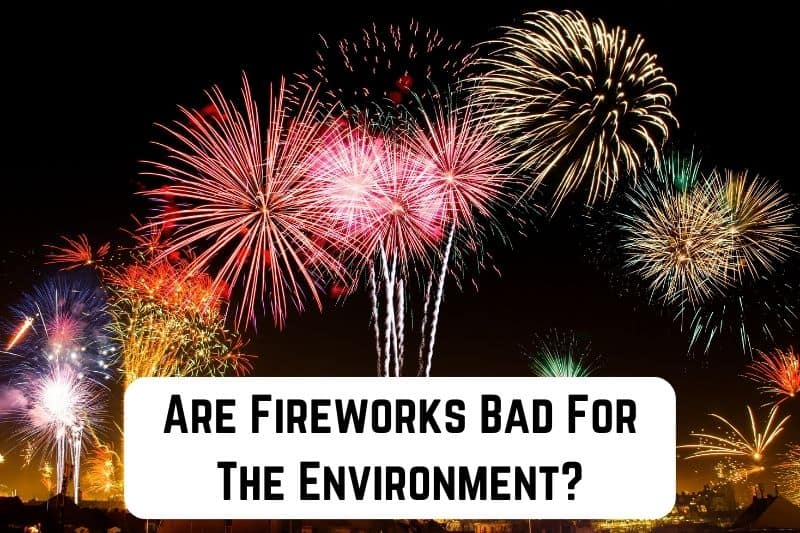New Year’s Eve and Bastille Day are two yearly fireworks fired worldwide. Although they represent amazement and joy, they also contribute to air pollution, which can harm the environment and human health.
Pretty fireworks will burst over your heads as all of your celebrations conclude. A mixture of chemicals, many hazardous to individuals and the environment, are released into the atmosphere by fireworks.
Read: Environmental Impact of Fireworks (And Alternatives)
What are Fireworks Made of?
Explosives and incandescent objects are used in fireworks, a pyrotechnic procedure that creates smoke, light, and noise. A firework’s primary fuel is black powder, which comprises 15% charcoal, 10% sulfur, and 75% saltpeter. An oxidizing agent, typically potassium perchlorate, makes up the remaining 10% to 15% of the powder.
The materials that fireworks comprise are among the reasons they harm the environment. Gunpowder, heavy metals, and other poisons are mixed to create the brilliant display of color that is fireworks.
Different metal complexes, including strontium, barium, aluminum, rubidium, and copper, produce the distinct hues we perceive in the atmosphere. Cadmium is another metal compound that is used as an all-purpose colorant for a variety of fireworks.
Given that cadmium is a proven human carcinogen, some of the pyrotechnics are blowing up with poisons that cause cancer. In essence, fireworks are made up of toxic chemicals, gunpowder, and other dangerous materials that, when they explode, cover our bodies, our land, and our water while we watch.
Fine metallic particles are used in fireworks to produce their varied colors. Every metal has a distinct color when heated during combustion. Copper gives blue hues. The vivid blue brilliance of fireworks made from copper creates a distinctive blue light when fired at high temperatures.
The metal lithium or strontium produces red. They give off a bright red light when added to pyrotechnic mixtures and fired, giving fireworks their bright red coloration. Barium is used in fireworks to create bright white or green colors. Barium emits a bright green light when heated. It can also help produce brilliant white bursts when combined with other substances.
Environmental Impact of Fireworks
Fireworks may impact both the environment and human health. They leak dangerous chemical compounds, heavy metals, and small particles into the land, water, and air as they burn. There is no mystical disappearance of the heavy metals as these fireworks burst. Instead, as aerosols, their atoms remain in the atmosphere, contaminating our earth, water, and air.
Loud Noise Disturbance
The combustion accompanies the loud bang. Numerous untamed creatures and even domesticated companions have demonstrated signs of severe anxiety and distress due to the loud sounds generated by the detonations. The Calgary Wildlife Rehabilitation Society (CWRS) notes increased animal sightings around the fireworks season peak in artificial areas.
Numerous incidents have been documented where small creatures or birds have abandoned their nests and young due to these abrupt noises. The unexpected disruptions can disorient wildlife and make it more difficult for them to migrate their families.
Water Pollution
As oxidizers, perchlorates are widely used in pyrotechnics to provide the necessary oxygen for their combustion reactions. Our priceless lakes and rivers and the aquatic life they support are all contaminated by these perchlorates, which also taint the water.
In addition to harming our waterways, perchlorates represent a risk of decreasing thyroid hormone synthesis, which is essential for the growth and evolution of the nervous system, if they pollute our drinking water sources.
Air Pollution
Smoke and other particulates are sent into the atmosphere by fireworks, which can worsen air pollution. Children, the elderly, and people with pre-existing respiratory illnesses are among the vulnerable groups that may experience respiratory problems as a result of these particles.

Do Fireworks Contribute To Global Warming?
Fireworks go through a chemical reaction called combustion that releases metals and salts. Later on, this process emits smoke and various gasses, such as nitrogen, carbon dioxide, and carbon monoxide. Regrettably, the cause of global warming is these three gasses.
The two leading gases released during fireworks are sulfur dioxide and nitrogen oxides. When these two gasses combine with atmospheric water vapor, acid rain results. As a result, excessive acid rain severely disrupts the weather and precipitation patterns, which can affect the stability of ecosystems and the ambient qualities of the land and water, ultimately altering the climate dynamics of the area.
Additionally, a high concentration of these gasses can cause wildfires, which pose a significant threat to the widespread survival of wild animals. Even though fireworks have a minimal direct impact on global warming, they have a noticeable environmental impact, particularly locally.
In addition to their ability to cause localized environmental consequences, fireworks can cause short-term rises in air pollution due to metal fragments and residues that settle in soil and water bodies.
It’s important to remember that conversations about how fireworks affect the environment frequently pick up steam around occasions like New Year’s Eve and other festivities when extravagant fireworks are customary. Using more ecologically friendly fireworks, such as ones with lower metal contents or different formulations, can help lessen the environmental impact.
Are There Eco-Friendly Fireworks?
Certain fireworks are less harmful to the environment than more conventional ones. These environmentally friendly fireworks produce 15 to 65% less particulate matter than conventional explosives, but they aren’t a perfect replacement.
By using ecologically friendly fireworks, you can reduce the carbon footprint of fireworks. The clean fuel for these fireworks is based on nitrogen. This indicates that the perchlorate components that cause the fireworks to oxidize are absent from them. Environmentally friendly fireworks are made to cause the least pollution to the environment.
Pyrotechnics release a lot of smoke, new metal compounds, and pollutants called perchlorates when they burn, despite their impressive appearance. Sulfur, charcoal fuel, perchlorate oxidizer—which aids in combustion—colorants, binders, and fuels are used to produce other pyrotechnics.
However, the fuel used in environmentally friendly pyrotechnics is based on nitrogen and burns cleanly. This indicates that the perchlorate oxidizer is not present. Instead, they create vividly colored flames using tiny amounts of metal salts.

Alternatives to Lighting Fireworks
Fireworks are a fantastic way to celebrate any occasion, be it New Year’s Day or any other festival, or no occasion at all. Regrettably, fireworks pose a significant environmental risk. Wildlife is disturbed when they are set off, and dangerous substances like carbon dioxide, carbon monoxide, and sulfur dioxide are released into the atmosphere. Thankfully, there are a few more eco-friendly choices to consider.
Go to a Public Fireworks Display
If you still can’t get enough fireworks, view them from a secure distance at a communal display rather than setting off your own. Watch them on TV instead. In this manner, you will not be adding to the existing garbage or pollution.
View a Laser or Light Show
Although lights and lasers require electricity, this energy can come from renewable sources, and since lasers can be used repeatedly, they are cleaner than fireworks. Laser or light shows are excellent substitutes for fireworks since they provide the same excitement as the lights.
Use Glow Sticks
Particularly among kids, glow sticks are a fun substitute for pyrotechnics. Since most glow sticks are constructed of single-use plastic, they are not environmentally friendly; nevertheless, some companies provide ecologically friendly glow sticks.
Read: How to Dispose of Gunpowder Sustainably?
Use Light-up Toys
Light-up toys can be found at various events, including fireworks and circus performances. Despite being constructed of plastic, they are meant to be reused again. Several of these toys are noisy and function exceptionally well in low light. Disco lights are equally helpful at home.
Throw Confetti
It is possible to use confetti sustainably. You may create your own using colorful recyclable paper as long as it gets picked up later. Another option is Confetti tubes; however, get recyclable ones. Invest in biodegradable confetti if you intend to toss it outside. Confetti, like fireworks, creates colorful displays. You can design your displays and select the colors you wish to use.
FAQ’s
Do fireworks affect wildlife?
Fireworks create a lot of noise, which can stress and disorient wildlife. The accumulation of metal deposits in water bodies may also impact aquatic life.
How do fireworks affect air quality?
Short-term drops in air quality can result from fireworks because they release pollutants into the environment. Firework displays can cause respiratory problems due to the particles and chemicals released, particularly for people with health disorders.
Can fireworks be harmful to human health?
Fireworks can release smoke and particulate matter that damages people’s health, especially those with respiratory issues. Nearby fireworks displays may momentarily worsen the air quality.
What can be done to minimize the environmental impact of fireworks?
Using substitutes with less metal, placing displays away from delicate ecosystems, and raising public awareness of responsible fireworks use are ways to lessen the impact of pyrotechnics.
Conclusion
The world’s greatest way to celebrate New Year’s Eve and other holidays is with a fireworks display, and this popularity is growing. This means that to lessen the adverse effects that traditional fireworks have on the environment, sustainable fireworks choices need to be taken into consideration right now.
It’s crucial to remember that fireworks have a complicated effect on the environment, and how much of an impact depends on several variables, including the kind of fireworks used, the size of the display, and the surrounding circumstances.






